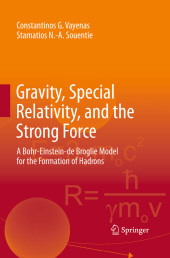 Neuerscheinungen 2016Stand: 2020-02-01 |
Schnellsuche
ISBN/Stichwort/Autor
|
Herderstra▀e 10
10625 Berlin
Tel.: 030 315 714 16
Fax 030 315 714 14
info@buchspektrum.de |

Stamatios N.-A. Souentie, Constantinos G. Vayenas
(Beteiligte)
Gravity, Special Relativity, and the Strong Force
A Bohr-Einstein-de Broglie Model for the Formation of Hadrons
Softcover reprint of the original 1st ed. 2012. 2016. xviii, 144 S. 5 Tabellen. 235 mm
Verlag/Jahr: SPRINGER, BERLIN; SPRINGER US; SPRINGER 2016
ISBN: 1-489-97820-8 (1489978208)
Neue ISBN: 978-1-489-97820-2 (9781489978202)
Preis und Lieferzeit: Bitte klicken
This book shows that strong interaction forces, which keep hadrons and nuclei together, are relativistic gravitational forces exerted between very small particles in the mass range of neutrinos. Discusses implications for unification of forces and much more.
This book shows that the strong interaction forces, which keep hadrons and nuclei together, are relativistic gravitational forces exerted between very small particles in the mass range of neutrinos. First, this book considers the motion of two or three charged particles under the influence of electrostatic and gravitational forces only, which shows that bound states are formed by following the same semi-classical methodology used by Bohr to describe the H atom. This approach is also coupled with Newton┤s gravitational law and with Einstein┤s special relativity.
The results agree with experiments on the masses, binding energies, radii, angular moments and magnetic moments of hadrons. The model provides the means to rationalize all the main experimental features of the strong force. Some of the implications for the unification of forces and the nature of our micro-cosmos and macro-cosmos are also discussed. The creation of mass itself, in other words, of hadrons from particles as light as neutrinos, can now be modeled in a straightforward manner.
1905-1930: The golden age of physics.- Mass, special relativity and the equivalence principle.- The strong force: From quarks to hadrons and nuclei.- The world of particles and the standard model.- The equivalence principle, special relativity and Newton┤s gravitational law.- The three and two rotating neutrino models: Particle confinement by gravity.- Energy and other properties of the rotational states.- Gravitational hadronization: How mass can be produced from gravity.- Model comparison with the main experimental features of the strong interaction force.- The Bohr-de Broglie approach in physics: The dual nature of matter.- Gravity at relativistic velocities and dark matter.- Force unification: Is the strong force simply gravity?.


